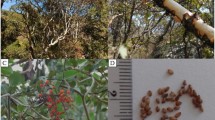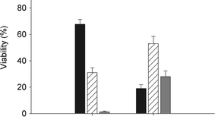Abstract
Effective seed storage methods for orchid species provide a unique opportunity to preserve large amounts of germplasm. Early evaluation of the physiological status of seeds is useful for selecting seed lots for conservation. To score seed quality, seeds from nine Cattleya species (Cattleya granulosa, Cattleya hegeriana, Cattleya intermedia, Cattleya mossiae, Cattleya purpurata, Cattleya sanguiloba, Cattleya tenuis, Cattleya tigrina and Cattleya walkeriana) were germinated on Knudson C medium and viability was measured using a tetrazolium (TZ) test following pre-conditioning in a 10% sucrose solution, both before and after storage at −18°C for 3 mo. Tetrazolium test results were quantified using digital imaging of germinating seeds on a flatbed scanner. Seed viability (with or without pre-conditioning in sucrose), germination, Germination Velocity Index (GVI) and the correlation between viability measurements and germination were also evaluated. Both the tetrazolium test and the germination results showed that there was no loss of viability after storage, although in five seed lots, the GVI decreased. Pre-conditioning improved the correlation between viability exhibited in the tetrazolium test and seed germination. Image analysis proved to be a powerful tool for analysing these small seeds.






Similar content being viewed by others
References
Alvarez-Pardo V.; Ferreira A. G. Armazenamento de sementes de orquídeas. Rev Bras Sementes 28: 92–98; 2006.
Alvarez-Pardo V.; Ferreira A. G.; Nunes V. F. Seed disinfestation methods for in vitro cultivation of epiphyte orchids from southern Brazil. Horticul Bras 24: 217–220; 2006.
Arditti J. Aspects of the physiology of orchids. Adv Bot Res 7: 21–655; 1980.
Arditti J. Fundamentals of orchid biology. John Wiley & Sons, New York; 1992.
Arditti J.; Ghani A. K. A. Numerical and physical properties of orchid seeds and their biological implications. New Phytol 145: 367–421; 2000.
Ávila-Diaz I.; Oyama K.; Gómez-Alonso C.; Salgado-Garciglia R. In vitro propagation of the endangered orchid Laelia speciosa. Plant Cell Tiss Organ Cult 99: 335–343; 2009.
Bailly C.; Benamar A.; Corbineau F.; Come D. Changes in malondialdehyde content and in superoxide dismutase, catalase and glutathione reductase activities in sunflower seed as related to deterioration during accelerated aging. Physiol Plant 97: 104–110; 1996.
Batty A. L.; Dixon K. W.; Brundrett M.; Sivasithamparam K. Constraints to symbiotic germination of terrestrial orchid seed in a mediterranean bushland. New Phytol 152: 511–520; 2001.
Begnami C. N.; Cortelazzo A. L. Cellular alterations during accelerated ageing of French beans seeds. Seed Sci Technol 24: 295–303; 1996.
Benson E. E. Cryopreservation theory. In: Reed B. M. (ed) Plant cryopreservation: A practical guide. Springer, New York, pp 15–32; 2008.
Bewley J. D.; Black M. Seeds: Physiology of development and germination. Plenum Press, New York; 1994.
Bidartondo M. I.; Read D. J. Fungal specificity bottlenecks during orchid germination and development. Mol Ecol 17: 3707–3716; 2008.
BRASIL; Ministério do Meio Ambiente (2008) Lista Oficial das Espécies da Flora Ameaçada de Extinção (Anexo I) e Lista Oficial da Flora Brasileira com Deficiências de Dados. Diário Oficial da União, Brasília, DF, 24 set. 2008. http://www.mma.gov.br/estruturas/ascom_boletins/_arquivos/83_19092008034949.pdf. Cited 16 Jan. 2008.
Custódio C. C. Testes rápidos para avaliação do vigor de sementes: uma revisão. Colloq Agrar 1: 29–41; 2005.
Dell’Aquila A. Application of a computer-aided image analysis system to evaluate seed germination under different environmental conditions. Italian J Agron 8: 51–62; 2004.
Dell’Aquila A. Towards new computer imaging techniques applied to seed quality testing and sorting. Seed Sci Technol 35: 519–538; 2007.
Dressler R. L. How many orchid species? Selbyana 26: 155–158; 2005.
Ellis R. H.; Hong T. D. Seed longevity - moisture content relationships in hermetic and open storage. Seed Sci Technol 35: 423–431; 2007.
Ferreira D. F. SISVAR: um programa para análises e ensino de estatística. Revista Symposium 6: 36–41; 2008.
Ferreira R. A.; Guimarães M. G. G. C.; von Pinho E. V. R.; Tonetti O. A. O. Morfologia de sementes e plântulas e avaliação da viabilidade da semente de sucupira-branca (Pterodon pubescens Benth Fabaceae) pelo teste de tetrazólio. Rev Bras Sementes 23: 108–115; 2001.
França-Neto J.B. Teste de tetrazólio para determinação do vigor de sementes. In: Krzyzanowski FC.; Vieira RD.; França Neto JB. Vigor de Sementes: Conceitos e Testes. Associação Brasileira de tecnologia de sementes, Comitê de vigor de sementes. ABRATES, Londrina: 218 p; 1999.
Geneve R. L.; Kester S. T. Evaluation of seedling size following germination using computer aided analysis of digital images from a flat bed scanner. HortSci 36: 1117–1120; 2001.
Harrington J.F. The value of moisture resistant containers in vegetable seed packing. Davis, California Agricultural Experiment Station, 23 p. (Bulletin 792); 1963.
Hosomi S. T.; Santos R. B.; Custodio C. C.; Seaton P. T.; Marks T. R.; Machado-Neto N. B. Pre-conditioning Cattleya seeds to improve the efficacy of the tetrazolium test for viability. Seed Sci Technol 139: 178–189; 2011.
IUCN. Orchids: Status survey and conservation action plan. Hagsáter E.; Dumont, V. (eds). Graphic Express, Los Gatos; 1996.
Knudson L. A new nutrient solution for the germination of orchid seed. Am Orchid Soc Bull 15: 214–217; 1946.
Koopowitz H. Orchids and their conservation. Timber Press, Portland; 2001.
Long B.; Niemieria A. X.; Cheng Z-y; Long C-l. In vitro propagation of four threatened Paphiopedilum species (Orchidaceae). Plant Cell Tiss Organ Cult 101: 151–162; 2010.
Machado-Neto N. B.; Custódio C. C. A medium for non-commercial sowing of orchid seed. Selbyana 26: 316–317; 2005a.
Machado-Neto N. B.; Custódio C. C. Orchid conservation through seed banking: ins and outs. Selbyana 26: 229–235; 2005b.
Maguire J. D. Speed of germination aid in selection and evaluation of seedling emergence and vigor. Crop Sci 2: 176–177; 1962.
McDonald M. B.; Evans A. F.; Bennett M. A. Using scanners to improve seed and seedling evaluations. Seed Sci Technol 29: 683–689; 2001.
Mendonça E. A. F.; Ramos N. P.; Paula R. C. Viabilidade de sementes de Cordia trichotoma (Vellozo) Arrabida ex Steudel (louro-pardo) pelo teste de tetrazólio. Rev Bras Sementes 23: 64–71; 2001.
Perán R.; Pammenter N. W.; Naicker J.; Berjak P. The influence of rehydration technique on the response of recalcitrant seed embryos to desiccation. Seed Sci Res 14: 179–184; 2004.
Pritchard H. W.; Poynter A. L. C.; Seaton P. T. Interspecific variation in orchid seed longevity in relation to ultra-dry storage and cryopreservation. Lindleyana 14(2): 92–101; 1999.
Pritchard H. W.; Seaton P. T. Orchid seed storage: Historical perspective, current status, and future prospects for long- term conservation. Selbyana 14: 89–104; 1993.
Rasmussen H. N. Terrestrial orchids from seed to mycotrophic plants. University Press, Cambridge; 1995.
Santos M. F.; Ribeiro W. R. C.; Faiad M. G. R.; Salomão A. N. Avaliação da qualidade sanitária e fisiológica das sementes de caroba (Cybistax antisyphilitica (Mart.) Mart.). Rev Bras Sementes 20: 1–6; 1998.
Seaton P. T.; Hailes N. S. J. (1989) Effect of temperature and moisture content on viability of Cattleya aurantiaca seed. In: Pritchard H. W. (ed) Modern methods in orchid conservation: The role of physiology, ecology and management. University Press, Cambridge, pp 17–29; 1989.
Seaton P. T.; Pritchard H. W. Life in the freezer. Orchids 77: 762–773; 2008.
Secretaria da Meio Ambiente do Estado de Minas Gerais. Lista das Espécies Presumivelmente Ameaçadas de Extinção da Flora do Estado de Minas Gerais. http://www.biodiversitas.org.br/listasmg/MG-especies-presumivelmente-ameacadas.pdf. Cited 15 Mar 2009; 1997.
Secretaria do Meio Ambiente do Estado de São Paulo Resolução SMA - 48 Lista Oficial das Espécies da Flora do Estado de São Paulo Ameaçadas de Extinção. Diário Oficial. São Paulo, SP, 23 set. 2004. p. 114. http://imprensaoficial.com.br/PortalIO/DO/BuscaDO2001Documento_11_4.aspx?link=/2004/executivo%20secao%20i/setembro/22/Pag_0026.pdf&pagina=26&data=22/09/2004&caderno=Executivo I. Cited 15 March 2009; 2004.
Secretaria do Meio Ambiente do Estado do Rio Grande do Sul. Lista da Flora Ameaçada de Extinção do Rio Grande do Sul. 2002. http://www.al.rs.gov.br/legis/M010/M0100099.ASP?Hid_Tipo=TEXTO&Hid_TodasNormas=320&hTexto=&Hid_IDNorma=320. Cited 22 August 2011; 2002.
Shoushtari B. D.; Heydari R.; Johnson G. L.; Arditti J. Germination and viability staining of orchid seeds following prolonged storage. Lindleyana 9: 77–84; 1994.
Souza V.C.; Lorenzi H. Botânica sistemática - Guia ilustrado para identificação das Fanerógamas nativas e exóticas no Brasil, baseado em APG II. 2. Instituto Plantarum, Nova Odessa; 2008.
van den Berg C. New combinations in the genus Cattleya Lindl. (Orchidaceae). Neodiversity 3: 3–12; 2008.
Vujanovic V.; St-Arnaud M.; Barabé D.; Thibeault G. Viability testing of orchid seed and the promotion of colouration and germination. Ann Bot 86: 79–86; 2000.
Wright M.; Guest D. Development of mycorrhizal associations in Caladenia tentaculata. Selbyana 26: 114–124; 2005.
Yamazaki J.; Miyoshi K. In vitro germination of immature seed and formation of protocorm by Cephalanthera falcate (Orchidaceae). Ann Bot 98: 1197–1206; 2006.
Acknowledgements
We would like to thank the Orchid Seed Stores for Sustainable Use (OSSSU) Project, which is supported by the Defra UK–Darwin Initiative (project no. 16-012), and UNOESTE that supported the development of the research.
Author information
Authors and Affiliations
Corresponding author
Additional information
Editor: J. Finer
Rights and permissions
About this article
Cite this article
Hosomi, S.T., Custódio, C.C., Seaton, P.T. et al. Improved assessment of viability and germination of Cattleya (Orchidaceae) seeds following storage. In Vitro Cell.Dev.Biol.-Plant 48, 127–136 (2012). https://doi.org/10.1007/s11627-011-9404-1
Received:
Accepted:
Published:
Issue Date:
DOI: https://doi.org/10.1007/s11627-011-9404-1




